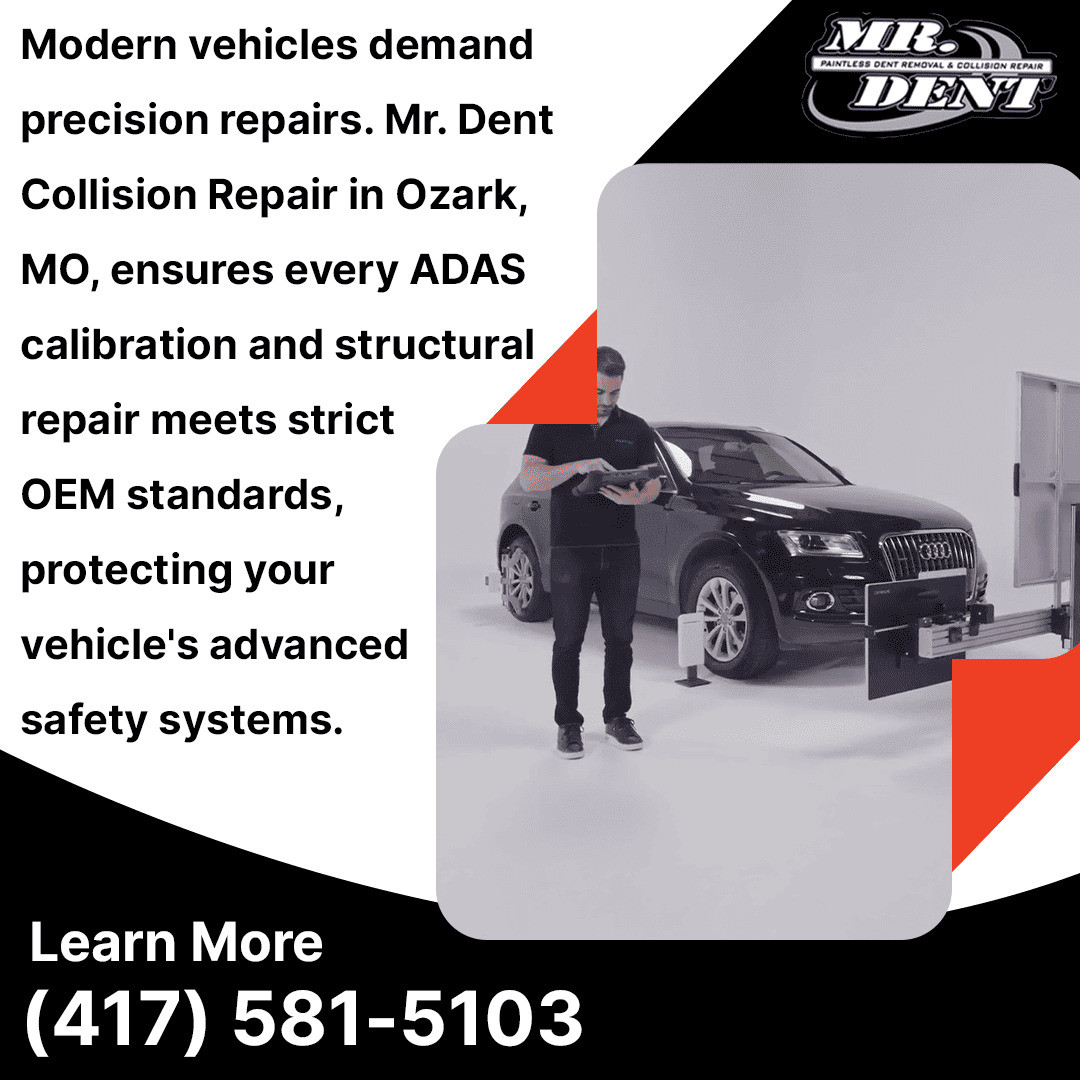Ozark, MO – Modern vehicle repairs require more than cosmetic fixes. A comprehensive approach to collision restoration now demands strict adherence to manufacturer specifications, electronic system validation, and documented verification at every stage. Mr. Dent Collision Repair, serving southwest Missouri's Ozark and Christian County communities, has released detailed information on how compliance-driven processes protect vehicle safety, warranty coverage, and insurance claim accuracy.
How OEM Compliance Protects Structural Integrity and Electronic Systems
Compliance in auto body collision repair means executing every procedure exactly as the manufacturer designed. Even minor deviations from factory specifications can compromise crash energy absorption, sensor alignment, and corrosion resistance. Modern vehicles integrate dozens of electronic safety systems that require precise calibration following any structural work.
Critical compliance elements include:
- Pre-scan diagnostics capturing electronic faults before repair begins
- Frame measurement and correction to exact factory dimensions
- Factory-approved welding techniques matching metal type and thickness
- ADAS calibration with post-repair verification using certified equipment
- Controlled paint refinishing environments for proper curing
- Complete documentation of every procedure with time-stamped records
Frame geometry variations of just a few millimeters can alter how crash energy is distributed through the structure. Radar or camera sensors mounted one degree off specification can misjudge distances during automatic braking events. Missing corrosion protection allows rust formation beneath visible surfaces.
I-CAR Gold Class Training Ensures Technical Precision
Repair professionals working in certified facilities must maintain current knowledge across metallurgy, adhesive bonding, sensor calibration, and vehicle electronics. The I-CAR Gold Class program provides ongoing education that adapts to evolving vehicle technologies introduced with each model year.
This training framework ensures technicians understand proper amperage for different steel grades, correct adhesive application for aluminum bonding, and calibration protocols for manufacturer-specific ADAS configurations. Continuous education creates measurable quality control throughout the repair process.
Insurance Documentation and Consumer Choice Rights
Missouri law allows vehicle owners to select any repair facility regardless of insurer recommendations. Comprehensive documentation supports insurance claims by providing verifiable evidence of work performed.
Proper insurance documentation includes:
- Estimates referencing manufacturer repair procedures by VIN
- Photographic evidence supporting supplemental charges
- OEM parts prioritization for safety-critical components
- Itemized calibration charges per affected system
- Post-scan reports confirming electronic system communication
This documentation protects warranty coverage and adds verifiable credibility during vehicle resale.
ADAS Calibration as Final Verification
Advanced Driver Assistance Systems embedded in bumpers, mirrors, and windshields require precise recalibration after any collision repair. These systems control lane-keeping assist, adaptive cruise control, automatic emergency braking, blind-spot detection, and parking monitoring.
Calibration protocols follow manufacturer instructions using level floors, measured distances, and certified targets. Each calibration produces a logged certificate proving the system operates within factory parameters. This verification step separates facilities that complete repairs from those that merely finish them.
Regional Standards for Southwest Missouri Drivers
Ozark and Christian County residents benefit from understanding specific compliance protections:
- Vehicle owners may choose any collision repair shop they trust
- OEM repair methods must be followed when safety systems are affected
- ADAS calibrations and diagnostic scans must be documented
- Supplemental estimates require photographic proof linked to vehicle identification
Common Compliance Failures That Compromise Safety
Facilities lacking proper protocols often make costly errors:
- Incorrect sectioning: Cutting body panels outside factory-designated zones weakens structural integrity
- Generic weld settings: Different metals require specific amperage and filler wire compositions
- Missing corrosion protection: Cavity wax and seam sealers must be reapplied per factory specifications
- Skipped calibration: Every ADAS system requires printed verification documentation
- Absent post-scan: Electronic confirmation between vehicle modules is mandatory
Professional facilities avoid these pitfalls through strict measurement and documentation protocols.
Selecting a Certified Repair Partner
When comparing facilities, Ozark-area drivers should verify:
- Active I-CAR Gold Class certification with ongoing technician training
- Documented frame measurement capability using manufacturer-certified equipment
- OEM-compatible diagnostic and calibration tools
- Controlled paint environments meeting refinishing standards
- Proven track record with complete insurance documentation
Mr. Dent Collision Repair maintains I-CAR Gold Class certification and operates specialized equipment, including Car-O-Liner measurement systems, Hunter DOS 3000 calibration tools, and Garmat paint booths. The facility serves as one of the trusted certified collision repair shops in Ozark, MO, delivering documented verification for every procedure performed.
Vehicle owners seeking compliance-driven restoration can schedule consultations to tour equipment, review documentation processes, and understand how OEM standards protect both safety and vehicle investment.
For certified repair consultation, contact Mr. Dent Collision Repair at (417) 581-5103. The facility is located in Ozark, Missouri, serving Christian County and surrounding southwest Missouri communities with verified, manufacturer-compliant collision restoration services.





